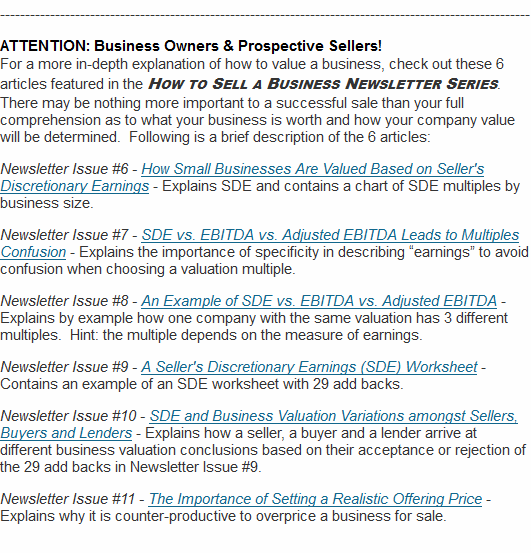Add Backs for Business Valuation
Small businesses are valued as a multiple of seller’s discretionary earnings. The purpose of add backs for business valuations is to adjust the earnings shown on a company’s taxable income to arrive at the amount of “true” earnings a buyer of the business can reasonably expect to have going forward for three purposes: 1) debt service on the acquisition; 2) reinvestment in the business; and 3) to enable the buyer to compensate himself/herself for their efforts in running the business. These types of adjustments are referred to as “recasting” or “normalizing” the financial results.
There are many types of add backs and it’s not surprising that sellers, buyers and lenders don’t always agree on the validity of add backs. For sellers and buyers, in evaluating the legitimacy of add backs it’s always best to keep in mind their purpose as stated in the previous paragraph: “to adjust the earnings shown on a company’s taxable income to arrive at the amount of ‘true’ earnings a buyer of the business can reasonably expect to have going forward ….” Lenders are usually more restrictive in their acceptance of add backs.
For more on how to value businesses check out this article here: how to value a business for sale
Add Backs Acceptable to Sellers, Buyers and Lenders
In addition to the standard add backs of EBITDA (interest, taxes, depreciation and amortization), when businesses are valued using seller’s discretionary earnings, owner’s compensation is always a valid add back. Also, particularly when the company owner also owns the facility the business occupies, the occupancy cost (think fair market value of a lease) must be adjusted to the costs a buyer should expect going forward. The occupancy cost adjustments would be positive (an add back) if the company’s current costs exceed the “going-forward” costs (i.e. business paying the owner more than market value for use of the facility), but would be negative (a reduction) if the opposite were true.
It’s not all that unusual for a small business to employ family members and pay those particular employees far above their true market value. For instance, the wife of a business owner may keep the books working part time about 30 hours/week and be paid a very high salary of $100,000. But a full-time bookkeeper could replace her function for about $35,000. In this example, an add back of $65,000 could be made, and should be acceptable to the buyer. The lender would also likely accept the add back, but may question it and have to be convinced of its validity. On the other hand, if the wife worked 30 hours/week, but received no compensation, it would be appropriate to negatively adjust the company’s earnings by about $35,000 because the buyer would have to replace the wife’s function by hiring a bookkeeper.


Occasionally businesses sell or trade tangible assets such as automobiles or equipment which results in a gain or a loss on the company’s books. These types of transactions are viewed as one-time occurrences (not reasonably expected to recur going forward), thus requires an adjustment. If the company recorded a loss on the sale, it’s an add back to earnings. If the company recorded a gain, it requires a negative adjustment to earnings.
Contributions to retirement plans that directly benefit the owner of the business are usually considered discretionary and are usually considered as valid add backs for business valuation. However, if a buyer intends to have his business entity contribute to retirement funds on his behalf, some lenders might not accept the adjustment because the funds are committed elsewhere, thus not available for debt service.
Many companies take advantage of early payment discounts offered my vendors (i.e. 2% in 10 days). The seller of the business has the excess cash flow to benefit from the vendor’s offer. However, the buyer of a business will have significant debt service and will not have the excess cash flow to take advantage of vendors’ discount offers. Therefore, earned discounts are usually logged as a negative adjustment to earnings.
Other Add Backs
Small business owners tend to run a lot of personal expenses through the business. Our Newsletter Issue #10, SDE and Business Valuation Variations amongst Sellers, Buyers and Lenders, displays a chart listing 14 items that sellers may try to utilize as add backs. However, buyers, and especially lenders, will dispute the validity of many add backs. The chart in the article has three columns to indicate whether the parties are likely to accept the attempted add backs. Despite the widespread knowledge that business owners run personal expenses through their business, lenders will not usually accept personal expenses as add backs for business valuation purposes. Buyers can be convinced to accept some add backs, but usually require documentation to prove the validity of the add back. If you are unable or unwilling to provide proof of add backs, they will usually not be accepted. For instance, sellers often want to add back unreported cash receipts they’ve pocketed. That’s almost impossible to prove, and thus not usually accepted by buyer. Additionally, it’s illegal and it’s not a good idea to admit illegal activities to someone with whom you are negotiating a sale of your business. You don’t want to give them ammunition to report you to the IRS!.





